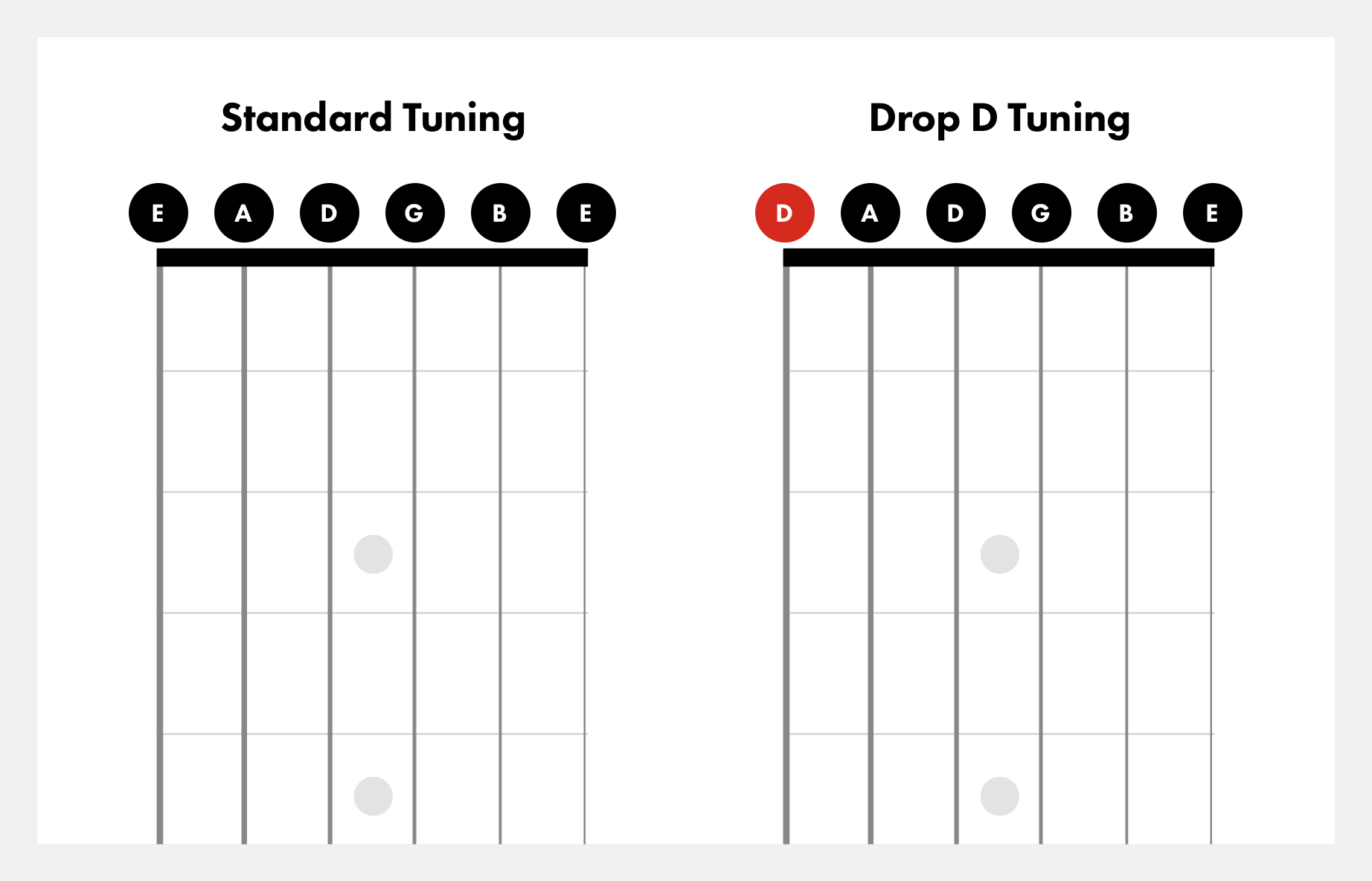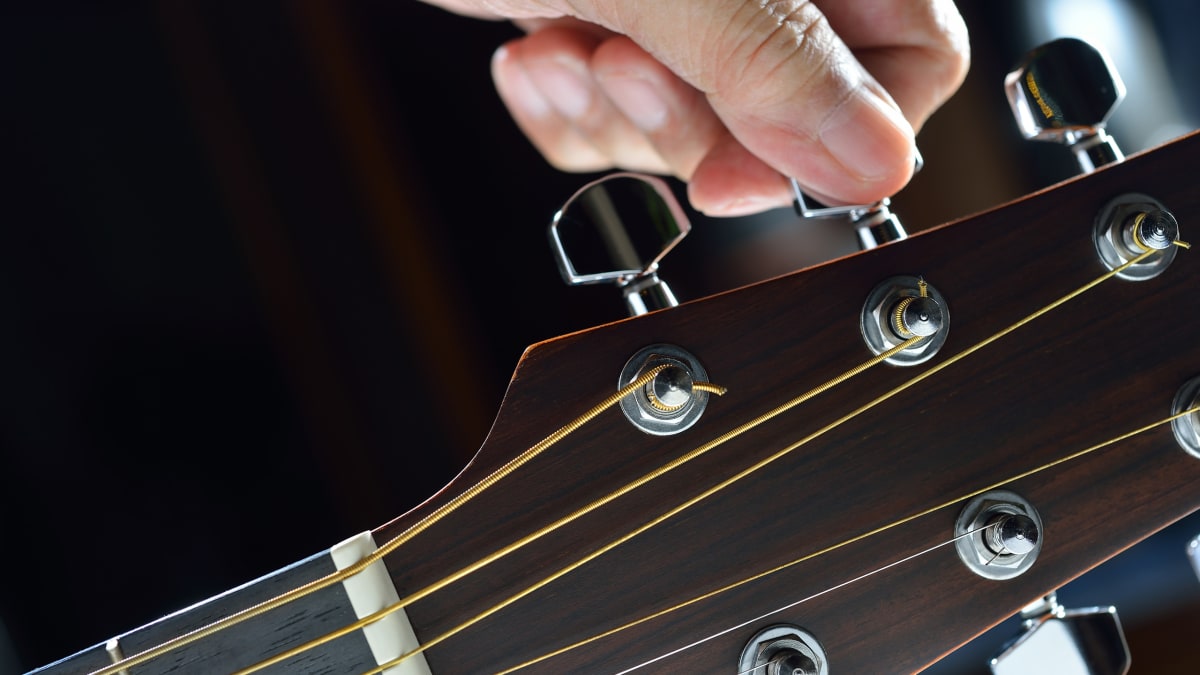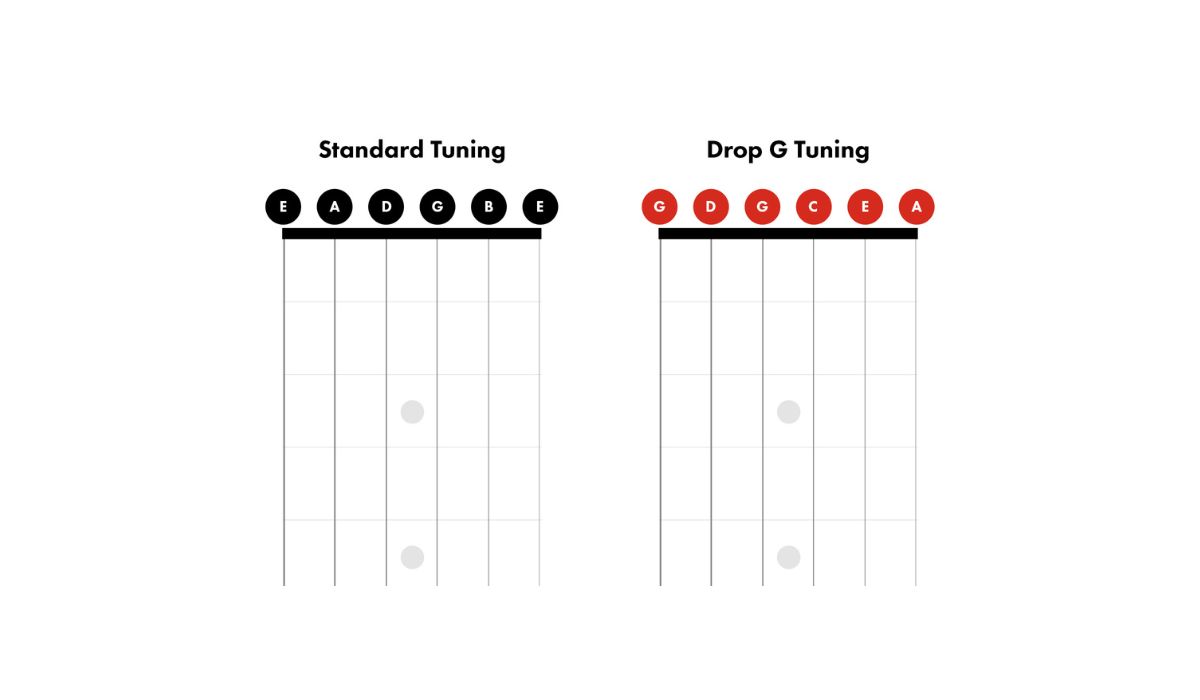Home>Instruments>Guitar>How To Tune A Guitar By Ear


Guitar
How To Tune A Guitar By Ear
Published: February 14, 2024
Learn how to tune a guitar by ear with our step-by-step guide. No need for a tuner - master the art of tuning your guitar effortlessly.
(Many of the links in this article redirect to a specific reviewed product. Your purchase of these products through affiliate links helps to generate commission for AudioLover.com, at no extra cost. Learn more)
Table of Contents
Introduction
Tuning a guitar by ear is a fundamental skill that every guitarist should master. While electronic tuners offer convenience and accuracy, developing the ability to tune by ear not only enhances your musical ear but also ensures that you can tune your instrument anytime, anywhere, without relying on external devices. This article will guide you through the process of tuning a guitar by ear, providing detailed instructions and valuable tips to help you achieve optimal tuning.
Tuning your guitar by ear allows you to develop a deeper connection with your instrument, as you become attuned to the subtle nuances of each string's pitch. It's a skill that has been passed down through generations of musicians and is an essential aspect of becoming a proficient guitarist. By understanding the standard tuning of a guitar and learning how to tune each string accurately, you'll gain a greater appreciation for the instrument's sonic capabilities and improve your overall musicality.
In this comprehensive guide, we will explore the intricacies of standard guitar tuning, offering a step-by-step approach to tuning each string by ear. Whether you're a beginner seeking to hone your tuning skills or an experienced guitarist looking to refine your ear, this article will equip you with the knowledge and techniques necessary to tune your guitar with precision and confidence. So, grab your guitar, and let's embark on this sonic journey together!
Understanding Standard Tuning
Standard tuning is the most common tuning for the six strings of a guitar, with each string typically tuned to a specific pitch. When the guitar is in standard tuning, the open strings, from the lowest pitch to the highest, are tuned to the following notes: E, A, D, G, B, and E. The lowest-pitched string, known as the sixth string or low E string, is located at the top when holding the guitar in playing position, while the highest-pitched string, the first string or high E string, is at the bottom.
Understanding the standard tuning is crucial for tuning your guitar by ear, as it provides the foundational reference points for achieving the correct pitch for each string. It’s important to familiarize yourself with the sound of each open string in standard tuning, as this will serve as the basis for tuning the guitar accurately without the aid of electronic tuners or other external tools.
Standard tuning allows for a versatile range of chord voicings, scale patterns, and musical possibilities, making it the preferred tuning for most styles of music. Whether you’re strumming chords, playing melodic riffs, or soloing, standard tuning provides a balanced configuration that facilitates fluid movement across the fretboard and harmonious chord progressions.
By internalizing the pitch of each string in standard tuning and recognizing their harmonic relationships, you’ll develop a keen sense of pitch and interval recognition, which are essential skills for tuning a guitar by ear. As we delve into the process of tuning each string, keep in mind the standard tuning notes and their sonic characteristics, as they will serve as your guideposts for achieving precise tuning without relying on external aids.
Tuning the Low E String
The low E string, also known as the sixth string, sets the foundation for the guitar’s pitch range. When tuning by ear, it’s essential to ensure that this string is accurately tuned to the note E. To begin, pluck the open low E string and listen to its pitch. If the string sounds lower or higher than the E note, you’ll need to adjust its tension accordingly.
To raise the pitch of the low E string, use the tuning peg corresponding to that string, typically located on the headstock of the guitar. Turn the tuning peg in a clockwise direction to tighten the string, gradually increasing the tension until the string’s pitch matches the E note. As you make adjustments, continue plucking the string and compare its pitch to the E note, making fine-tuned tweaks until they align.
If the string’s pitch is higher than the E note, you’ll need to loosen the tension by turning the tuning peg counterclockwise. Again, pluck the string intermittently as you make adjustments, aiming to bring the pitch down to the desired E note. It’s important to approach the tuning process with patience and attentiveness, as subtle adjustments can make a significant difference in achieving precise tuning.
As you hone your ability to tune the low E string by ear, pay close attention to the resonance and clarity of the note. A well-tuned low E string will resonate with a rich, full-bodied tone, free from any wavering or dissonance. Developing a discerning ear for pitch and timbre during this initial tuning stage will lay a solid foundation for the subsequent tuning of the remaining strings.
Mastering the art of tuning the low E string by ear not only cultivates your musical ear but also fosters a deeper connection with your instrument. As you attune yourself to the nuances of pitch and sound, you’ll develop a heightened sensitivity to the sonic intricacies of the guitar, setting the stage for a more immersive and rewarding musical experience.
Tuning the A String
After ensuring that the low E string is accurately tuned, the next step in tuning a guitar by ear is to focus on the A string, also known as the fifth string. The A string should be tuned to the note A in standard tuning, providing a harmonious transition from the low E string. Pluck the open A string and listen attentively to its pitch, comparing it to the A note reference.
If the A string’s pitch is lower than the A note, you’ll need to increase the tension by turning the corresponding tuning peg clockwise. As you make adjustments, continue to pluck the string intermittently, aiming to bring its pitch into alignment with the A note. It’s crucial to listen closely to the resonance and clarity of the string’s sound, ensuring that it resonates with a clear, unwavering pitch.
Conversely, if the A string’s pitch is higher than the A note, you’ll need to decrease the tension by turning the tuning peg counterclockwise. As with tuning the low E string, exercise patience and attentiveness, making gradual adjustments to fine-tune the string’s pitch. A well-tuned A string will exhibit a resonant and consistent tone, devoid of any wavering or discordant elements.
Developing the ability to tune the A string by ear not only enhances your musical ear but also fosters a deeper connection with the instrument. As you refine your ear for pitch and sound, you’ll cultivate a heightened sensitivity to the sonic nuances of the guitar, enriching your overall musical experience.
By mastering the art of tuning the A string by ear, you’ll gain confidence in your ability to achieve precise tuning without reliance on external devices. This foundational skill not only contributes to your development as a guitarist but also allows for greater flexibility and independence in tuning your instrument, empowering you to engage with your guitar on a more intuitive and immersive level.
Tuning the D String
Once the low E and A strings are accurately tuned, the next step in tuning a guitar by ear is to focus on the D string, the fourth string in standard tuning. The D string should be tuned to the note D, complementing the harmonic progression of the previously tuned strings. Pluck the open D string and attentively assess its pitch, comparing it to the reference note D.
If the pitch of the D string is lower than the D note, you’ll need to increase the tension by turning the corresponding tuning peg clockwise. Continuously pluck the string as you make adjustments, aiming to bring its pitch into alignment with the D note. It’s crucial to listen for the resonance and clarity of the string’s sound, ensuring that it resonates with a clear, unwavering pitch.
Conversely, if the D string’s pitch is higher than the D note, you’ll need to decrease the tension by turning the tuning peg counterclockwise. As with tuning the previous strings, exercise patience and attentiveness, making gradual adjustments to fine-tune the string’s pitch. A well-tuned D string will exhibit a resonant and consistent tone, devoid of any wavering or discordant elements.
Mastering the art of tuning the D string by ear not only enhances your musical ear but also fosters a deeper connection with the instrument. As you refine your ear for pitch and sound, you’ll cultivate a heightened sensitivity to the sonic nuances of the guitar, enriching your overall musical experience.
By developing the ability to tune the D string by ear, you’ll gain confidence in your capacity to achieve precise tuning without reliance on external devices. This foundational skill not only contributes to your development as a guitarist but also allows for greater flexibility and independence in tuning your instrument, empowering you to engage with your guitar on a more intuitive and immersive level.
Tuning the G String
After ensuring the accuracy of the low E, A, and D strings, the next step in tuning a guitar by ear is to focus on the G string, the third string in standard tuning. The G string should be tuned to the note G, contributing to the harmonious progression of the previously tuned strings. Pluck the open G string and attentively assess its pitch, comparing it to the reference note G.
If the pitch of the G string is lower than the G note, you’ll need to increase the tension by turning the corresponding tuning peg clockwise. Continuously pluck the string as you make adjustments, aiming to bring its pitch into alignment with the G note. It’s crucial to listen for the resonance and clarity of the string’s sound, ensuring that it resonates with a clear, unwavering pitch.
Conversely, if the G string’s pitch is higher than the G note, you’ll need to decrease the tension by turning the tuning peg counterclockwise. As with tuning the previous strings, exercise patience and attentiveness, making gradual adjustments to fine-tune the string’s pitch. A well-tuned G string will exhibit a resonant and consistent tone, devoid of any wavering or discordant elements.
Mastering the art of tuning the G string by ear not only enhances your musical ear but also fosters a deeper connection with the instrument. As you refine your ear for pitch and sound, you’ll cultivate a heightened sensitivity to the sonic nuances of the guitar, enriching your overall musical experience.
By developing the ability to tune the G string by ear, you’ll gain confidence in your capacity to achieve precise tuning without reliance on external devices. This foundational skill not only contributes to your development as a guitarist but also allows for greater flexibility and independence in tuning your instrument, empowering you to engage with your guitar on a more intuitive and immersive level.
Tuning the B String
With the low E, A, D, and G strings accurately tuned, the next step in tuning a guitar by ear is to focus on the B string, the second string in standard tuning. The B string should be tuned to the note B, complementing the harmonic progression of the previously tuned strings. Pluck the open B string and attentively assess its pitch, comparing it to the reference note B.
If the pitch of the B string is lower than the B note, you’ll need to increase the tension by turning the corresponding tuning peg clockwise. Continuously pluck the string as you make adjustments, aiming to bring its pitch into alignment with the B note. It’s crucial to listen for the resonance and clarity of the string’s sound, ensuring that it resonates with a clear, unwavering pitch.
Conversely, if the B string’s pitch is higher than the B note, you’ll need to decrease the tension by turning the tuning peg counterclockwise. As with tuning the previous strings, exercise patience and attentiveness, making gradual adjustments to fine-tune the string’s pitch. A well-tuned B string will exhibit a resonant and consistent tone, devoid of any wavering or discordant elements.
Mastering the art of tuning the B string by ear not only enhances your musical ear but also fosters a deeper connection with the instrument. As you refine your ear for pitch and sound, you’ll cultivate a heightened sensitivity to the sonic nuances of the guitar, enriching your overall musical experience.
By developing the ability to tune the B string by ear, you’ll gain confidence in your capacity to achieve precise tuning without reliance on external devices. This foundational skill not only contributes to your development as a guitarist but also allows for greater flexibility and independence in tuning your instrument, empowering you to engage with your guitar on a more intuitive and immersive level.
Tuning the High E String
As we approach the culmination of tuning a guitar by ear, the final step involves focusing on the high E string, the first string in standard tuning. The high E string should be tuned to the note E, completing the harmonic progression of the previously tuned strings. Pluck the open high E string and attentively assess its pitch, comparing it to the reference note E.
If the pitch of the high E string is lower than the E note, you’ll need to increase the tension by turning the corresponding tuning peg clockwise. Continuously pluck the string as you make adjustments, aiming to bring its pitch into alignment with the E note. It’s crucial to listen for the resonance and clarity of the string’s sound, ensuring that it resonates with a clear, unwavering pitch.
Conversely, if the high E string’s pitch is higher than the E note, you’ll need to decrease the tension by turning the tuning peg counterclockwise. As with tuning the previous strings, exercise patience and attentiveness, making gradual adjustments to fine-tune the string’s pitch. A well-tuned high E string will exhibit a resonant and consistent tone, devoid of any wavering or discordant elements.
Mastering the art of tuning the high E string by ear not only enhances your musical ear but also fosters a deeper connection with the instrument. As you refine your ear for pitch and sound, you’ll cultivate a heightened sensitivity to the sonic nuances of the guitar, enriching your overall musical experience.
By developing the ability to tune the high E string by ear, you’ll gain confidence in your capacity to achieve precise tuning without reliance on external devices. This foundational skill not only contributes to your development as a guitarist but also allows for greater flexibility and independence in tuning your instrument, empowering you to engage with your guitar on a more intuitive and immersive level.
Final Check and Tips
After tuning each string by ear, it’s essential to conduct a final check to ensure that your guitar is in optimal tune. Play a few chords and individual notes across the fretboard, listening for any discrepancies in pitch or tuning. This comprehensive check allows you to assess the overall harmony and coherence of your guitar’s tuning, making any necessary adjustments to individual strings as needed.
As you refine your skills in tuning a guitar by ear, consider the following tips to enhance your tuning proficiency:
- Develop a Tuning Routine: Incorporate regular tuning sessions into your practice routine to reinforce your ear-training and tuning abilities.
- Use Reference Tones: Listening to reference tones or pitches can aid in internalizing the correct pitch for each string, refining your sense of pitch accuracy.
- Practice Patience: Tuning by ear requires patience and attentiveness. Embrace the process and allow yourself time to make precise adjustments.
- Listen Closely: Pay attention to the resonance, sustain, and clarity of each string’s pitch, honing your ability to discern subtle variations in tuning.
- Embrace Imperfection: Tuning by ear is an organic and dynamic process. Embrace the nuances of each string’s sound, recognizing that slight variations contribute to the instrument’s unique character.
By incorporating these tips into your tuning practice, you’ll further refine your ability to tune a guitar by ear, fostering a deeper connection with your instrument and honing your musical ear. Embracing the art of tuning by ear not only enhances your technical skills but also enriches your musical journey, allowing you to engage with your guitar in a more intuitive and immersive manner.
Conclusion
Mastering the art of tuning a guitar by ear is a transformative journey that not only hones your technical skills but also deepens your connection with the instrument. By understanding the standard tuning of a guitar and developing the ability to tune each string by ear, you embark on a sonic exploration that enhances your musical ear and fosters a profound appreciation for the nuances of pitch and sound.
As you progress through the process of tuning each string, from the resonant low E string to the delicate high E string, you refine your ear for pitch, honing your ability to discern subtle variations and achieve precise tuning without reliance on external devices. This foundational skill empowers you to engage with your guitar on a more intuitive and immersive level, fostering a deeper musical connection and enhancing your overall playing experience.
Embracing the organic and dynamic nature of tuning by ear allows you to cultivate a heightened sensitivity to the sonic intricacies of the guitar, enriching your musical journey with a deeper understanding of pitch, resonance, and harmonious balance. By incorporating regular tuning sessions into your practice routine and embracing the nuances of each string’s sound, you’ll not only refine your tuning proficiency but also develop a profound connection with your instrument that transcends technical skill.
As you continue to refine your skills in tuning a guitar by ear, remember to practice patience, listen closely to the resonance of each string, and embrace the imperfections that contribute to the instrument’s unique character. These elements, combined with a dedicated tuning routine and a keen ear for reference tones, will further elevate your ability to achieve precise tuning and immerse yourself in the rich sonic tapestry of the guitar.
Ultimately, the art of tuning a guitar by ear is a deeply rewarding pursuit that enhances your musicality, fosters independence in tuning, and imbues your playing with a heightened sense of connection and expression. Embrace this sonic journey, hone your ear for pitch, and revel in the harmonious resonance of your finely-tuned instrument as you continue to explore the boundless possibilities of music and creativity.











